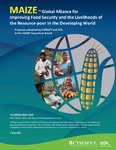Mostrar el registro sencillo del ítem
Maize - global alliance for improving food security and the livelihoods of the resource-poor in the developing world: proposal submitted by CIMMYT and IITA to the CGIAR Consortium Board
| Año: | 2011 |
| URI: | http://hdl.handle.net/10883/670 |
| Resumen: | Recurrent food price crises—combined with the global financial meltdown, volatile energy prices, natural resource depletion, and climate change—threaten the livelihoods of millions of poor people. Together with rice and wheat, maize provides at least 30% of the food calories of more than 4.5 billion people in 94 developing countries. They include 900 million poor consumers for whom maize is the preferred staple, 120 ‐140 million poor farm families and about one‐third of all malnourished children. Between now and 2050, the demand for maize in the developing world will double, and by 2025 maize will have become the crop with the greatest production globally and in the developing world. But harvests at current levels of productivity growth will still fall short of demand and millions of farm families will remain in poverty. Unless vigorous measures are taken to stabilize food prices, accelerate yield growth, increase incomes from more productive, sustainable and resilient maize based systems, and give greater opportunities to women and young adults, the outcome will be less affordable food for millions of poor maize consumers, continuing poverty and childhood malnutrition, deforestation, soil degradation, reduced biodiversity, and accelerated depletion of water and fertilizer reserves. This challenge is the main reason that the CGIAR centers engaged in maize research, together with a community of over 350 public‐ and private‐sector partners worldwide, are implementing a new strategy for international maize research. The strategy is designed to ensure that publicly‐funded international agricultural research helps most effectively to stabilize maize prices and double the productivity of maize‐based farming systems, making them more resilient and sustainable and significantly increasing farmers’ income and livelihood opportunities, without using more land and as climates change and fertilizer, water, and labor costs rise. The strategy will support and greatly strengthen the efforts of national governments, the private sector, international, regional and local organizations, and farming communities, creating or capitalizing on synergies and building on the different skills, knowledge, and resources of the community that designed the strategy. For 900 million farmers and consumers in low‐ and middle‐income countries, maize is a preferred crop or food. Well over 90% of resource poor maize farmers and consumers live in tropical and subtropical areas of Africa, Asia, and Latin America. The first target group for MAIZE world‐wide is smallholders who live in stress‐prone environments and who have poor market access (typically both factors go together). This group includes an estimated 640 million poor people who live on USD 2 per day or less; 275 million are maize dependent and 72 million of those are malnourished children. The second target group comprises market‐oriented smallholders in more favorable production areas and with great potential to supply markets but who lack access to appropriate technology. This group includes 470 million poor, of whom 367 million are maize dependent and among whom there are at least 49 million malnourished children. Beyond these two target groups, there will be spill‐over benefits to other farmers in developing countries. The third target group includes poor maize consumers and governments in low and middle income countries affected by maize price fluctuations. At the core of the strategy are nine Strategic Initiatives (SIs). Of high priority for international maize research and reflecting partners’ feedback, the SIs are designed for integrated implementation to generate products and services that meet the needs and aspirations and leverage the capacities of regional and local research and development partners and smallholder farmers in the above‐mentioned target groups, in particular women and young adults. |
| Formato: | |
| Lenguaje: | English |
| Editor: | CIMMYT |
| Copyright: | CIMMYT manages Intellectual Assets as International Public Goods. The user is free to download, print, store and share this work. In case you want to translate or create any other derivative work and share or distribute such translation/derivative work, please contact CIMMYT-Knowledge-Center@cgiar.org indicating the work you want to use and the kind of use you intend; CIMMYT will contact you with the suitable license for that purpose. |
| Tipo: | Book |
| Región: | Global |
| Lugar de publicación: | Mexico |
| Páginas: | v, 176 pages |
| Agrovoc: | DISEASE RESISTANCE |
| Agrovoc: | GENOTYPE ENVIRONMENT INTERACTION |
| Agrovoc: | FOOD SECURITY |
| Agrovoc: | GENETIC RESOURCES |
| Agrovoc: | PLANT BREEDING |
| Agrovoc: | DISEASE RESISTANCE |
| Agrovoc: | GENOTYPE ENVIRONMENT INTERACTION |
| Agrovoc: | FOOD SECURITY |
| Agrovoc: | GENETIC RESOURCES |
| Agrovoc: | PLANT BREEDING |
| Autor corporativo: | Centro Internacional de Mejoramiento de Maíz y Trigo (CIMMYT) |
Ficheros en el ítem
Este ítem aparece en la(s) siguiente(s) colección(ones)
-
Institutional
Collection of CIMMYT institutional documents -
Maize
Maize breeding, phytopathology, entomology, physiology, quality, and biotech

